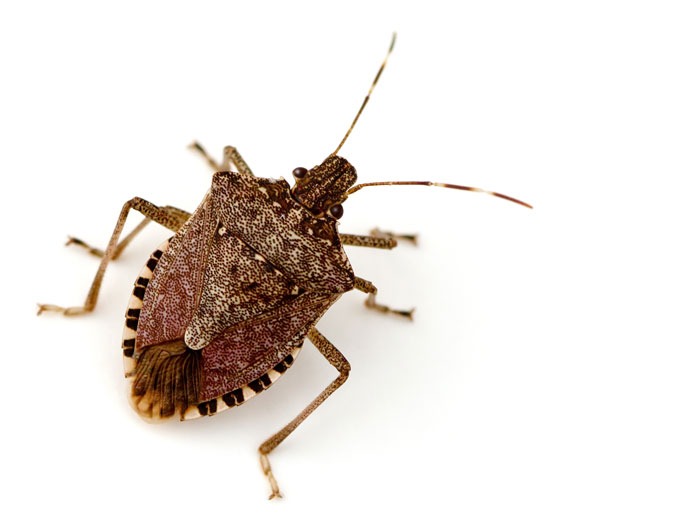
The brown marmorated stink bug is one of approximately 5,000 species of insects in the Pentatomidae (stink bug) family found around the world. Their name is derived from the foul-odored secretions they produce. The brown marmorated stink bug has the official scientific name of Halyomorpha halys.
The brown marmorated stink bug is also called a shield bug due to its body shape, which appears like a shield when its wings are flat on its back. They are referred to as the “brown marmorated” stink bug because of their overall mottled brown and gray coloring which also features white banding.
Adult brown marmorated stink bugs have six legs and grow to ¾ inches in length. Their bodies are often nearly as wide as they are long. They have wings and fully-developed adults can fly.
Brown marmorated stink bugs are designated an invasive species by the United States Department of Agriculture. Originating in eastern Asia, they were accidentally introduced into the United States in 1996 when they were discovered in Allentown, Pennsylvania. It is suspected that they arrived in the United States via shipping material. This hitchhiking pest soon traveled throughout the mid-Atlantic region and beyond and can now be found in 44 states.
Signs of an Infestation
Adult brown marmorated stink bugs have six legs and grow to ¾ inches in length. Their bodies are often nearly as wide as they are long. They have wings and fully-developed adults can fly.
Brown marmorated stink bugs are designated an invasive species by the United States Department of Agriculture. Originating in eastern Asia, they were accidentally introduced into the United States in 1996 when they were discovered in Allentown, Pennsylvania. It is suspected that they arrived in the United States via shipping material. This hitchhiking pest soon traveled throughout the mid-Atlantic region and beyond and can now be found in 44 states.
Inside, you may notice small clusters or a larger number of brown marmorated stink bugs gathering under beds or furniture, in or near windows, in attics, behind curtains and anywhere they can remain hidden from view. You will often notice their foul, musty odor before you see them.
Health and Damage Considerations
Brown marmorated stink bugs will not bite and are not known to be harmful to humans, except those who might experience an allergic reaction to the stink bug odor. They will not cause structural damage either. They are simply seeking a safe space to overwinter.
Stink bugs are an agricultural pest causing significant damage to crops throughout the mid-Atlantic region, leading to economic loss for farmers and impacting consumer prices. Prime targets include:
- Fruit trees & crops: peach, apple, pear, Asian pear, cherries, grapes, raspberries, blackberries and blueberries
- Vegetables & other crops: soybeans, field corn, sweet corn, peppers, tomatoes, eggplant, green beans, peas, swiss chard, okra, sunflowers
They feed on this vegetation causing external and internal tissue damage, ultimately making the fruits and vegetables unusable for consumption or mass production.
Behavior
Stink bugs do not organize into colonies. They travel alone. When they are discovered in groups – or even as an infestation – it is only because they are drawn to the same food source. As stated previously, they do fly and can travel up to three miles in one day if required.
Lifecycle
The brown marmorated stink bug generally produces one generation per year, with two generations per year possible in warmer spring and summer seasons.
In the spring adults will emerge from overwintering and after spending about two weeks feeding they will begin to mate, with the females depositing their eggs on the underside of leaves.
The mating season continues May through August and adult female stink bugs can produce multiple egg clutches across their lifespan, each containing up to 400 eggs. These eggs hatch within four to seven days.
The newly-hatched stink bug nymphs will pass through five instars. They will molt between each of these substages, becoming larger with each phase.
These nymphs have dark red eyes and a yellow-red abdomen with black stripes. Their legs and antennae are black with white bands.
Complete development from egg to adult will take 40 to 60 days.
Habitat
During the warmest months of the year the brown marmorated stink bug will live outdoors, seeking out host plants as food sources.
As the temperatures cool they begin to seek overwintering sites. In the outdoors that can include under the bark of older or dead trees, in fallen leaves, and among outdoor vegetation. They will gravitate toward indoor spaces, starting with external walls with sun exposure and making their way inside through windows and other access points.
Stink Bug Odor
Stink bugs are distinguishable by their odor. These foul smelling chemicals are released from the scent glands in their abdomens when they are under threat from predators. They will also release this chemical as a signal to other stink bugs that an overwintering site has been found. The odor is also released when the stink bug is squashed.
Feeding
Brown marmorated stink bugs are omnivores, feeding on fruit trees, ornamental plants, grasses, weeds, seeds, fruits and crops. Stink bugs will also feed on other insects and insect larvae, including caterpillars. They will not feed while overwintering.





